|
“The Transfiguration of Benjamin Banneker”
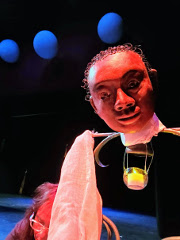 |
| Benajmin Banneker puppet. Photo by Chris Ignacio. |
LaMama E.T.C. (Ellen Stewart Theatre)
66 East 4th Street, NYC
Jan. 23-Feb. 2, 2020
Th.-Sat. at 7:00 p.m.; Sun. at 3:00
Box office 212-352-3101, www.lamama.org
Reviewed by Dorothy Chansky January 24, 2020
These days, “arts and sciences” sounds like about as
likely a pairing as, oh, maybe snowshoes and spaghetti, what with
STEM and humanities understood by so many as antitheses with no
hope of appeal across the aisle.
The eighteenth-century Benjamin Banneker felt and acted otherwise,
and in Theodora Skipitares’s inventive theatrical investigation
of this extraordinary man’s life, science inspires poetry
and sculpture, while painting is the realm of farmers and astronauts.
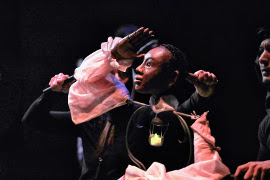 |
| Banneker Puppet. Photo by Theo Cote. |
Banneker, the son and grandson of African slaves, lived his life
as a free man on a farm in Maryland, from his birth in 1731 until
his death in 1806. He taught himself astronomy; he borrowed a pocket
watch and, after taking it apart, used it as a model to build himself
a clock that ran for fifty years without losing a second. He wrote
to Thomas Jefferson about racial inequity, decorously noting that
all humans belong to the same family and holding TJ’s feet
to the fire about that pesky “we hold these truths to be self-evident”
bit. He wrote several almanacs, using spherical trigonometry; he
predicted (accurately) four eclipses; he was a surveyor of the new
city of Washington, D.C.
His house and books were burned the day of his funeral. So much
for accomplishment and model citizenry on the wrong side of the
color line.
 |
| Banneker head with Soul Tigers in finale. Photo
by Theo Cote. |
As in many of Skipitares’s earlier works, a particular person
or event or category of experience provides the nodal point from
which this master puppet-maker and thinker makes cross-cultural,
transhistorical connections. Previous projects include pieces about
the history of medicine (“Under the Knife,” 1994) and
food as the stuff of myth, profit, and power-brokering (“Empires
and Appetites,” 1989). Her 2014 “Chairs” took
on Ionesco’s play by creating individual chairs “hosting”
twenty-nine (important, if not yet fully famous) guests, contra
the source text’s silent pieces of furniture to sit on which
no one ever arrived.
 |
| Reginald L. Barnes, the narrator who plays
Banneker and Edward Dwight, Jr. Photo by Kristina Loggia. |
Banneker’s fascination with the galaxy and the racism he
encountered provide a jumping-off place for Skipitares to make connections
with twentieth-century astronauts who have also gone on record about
the wonder—and the racism—they experience in relation
to space. Early in “Transfiguration” we hear Banneker
wax eloquent about his fascination with the universe: “The
moon is within me and so is the sun. Suppose we really are made
from the stars.” The Banneker puppet—in the Bunraku
family—has moveable arms and legs, but his torso is a hollow,
heart-shaped, metal frame with a bright light representing his actual
heart. Puppeteers who manipulate Banneker remain mostly in the shadows,
but occasionally they dance along with his utterances, a deft in/out
relationship between effigy and human as co-builders of what we
perceive as a character. (Puppetry Direction is by Jane Catherine
Shaw.)
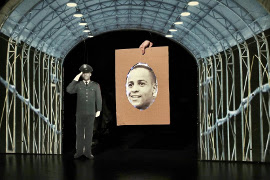 |
| Miniature toy theater, scene of
story of would-be astronaut Edward Dwight, Jr. Photo by Theo
Cote. |
Fast forward a couple of centuries. Consider the case of African
American space program trainee Edward Dwight, an 85-year-old sculptor
and astronaut manqué (yes, he’s still alive) who makes
a major appearance in “Transfiguration.” A Kansas native
interested in art, he walked away from an art school scholarship
when his father persuaded him to study engineering. His success
yielded an invitation from the Kennedy administration to join the
astronauts’ training program. Dwight was awed by the peacefulness
he experienced flying an F-104 Starfighter. Seeing our planet without
territorial borders and encased in what he describes as a magical
blue layer changed his life. He tells us that Russian astronauts
are nearly all also artists—the experience is that inspiring.
But NASA needed popular backing if it was to be profitable, and
Dwight realized that it is heroes who inspire followers. If heroic
work could be performed by women or blacks, however, it ceased to
be heroic to the American man in the street. Borman and Armstrong,
yes. Dwight? Not so much.
Borman also makes an appearance during a toy theatre sequence featuring
two-dimensional cut-out figures within a tiny proscenium ringed
by lights. He succinctly disses legendary instructor Chuck Yaeger
for the latter’s orders to the astronauts in training to shun
Dwight: “Do not socialize with him, do not drink with him,
do not invite him over to your house, and in six months he'll be
gone."
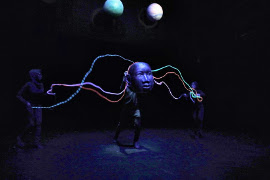 |
Banneker puppet. Photo
by Theo Cote. |
There is more to this show than skillful and imaginative puppetry
and zingy narrative. Students from the (NYC public high school)
Benjamin Banneker Academy’s marching band, the Soul Tigers,
provide drumming intervals, one of which works as a counterpoint
to Banneker’s correspondence with Thomas Jefferson, with explosive
snare riffs (Banneker) squaring off against less fireworksy bass
sequences (Jefferson). Dancers wielding and wearing strings and
rings of lights bring stars to life. (They are Banneker students
Adeoba Awosika, AnnJeane Cato, Isabel Elliott, Halle Gillett, Janee
Jeanbaptiste, and Kimori Zinnerman. Choreography is by by Edisa
Weeks in collaboration with Jasmine Oton and the performers.)
Banneker and Dwight, who have the bulk of the spoken text, are
compellingly voiced by Reginald L. Barnes. Tom Walker handles Jefferson
and Borman ably. Alexandria Joesica Smalls does a delicious turn
as Nichelle Nichols, the African American actress who played Uhura
on “Star Trek” and nearly left the show for opportunities
on Broadway until Martin Luther King told her she was part of history
and needed to stay in her non-gendered, non-raced role as a message
to all of America that “can do” in outer space, in Hollywood,
and on our streets isn’t confined to white, male “heroes.”
I wish I could conclude by channeling Jiminy Cricket crooning “When
you wish upon a star/Makes no difference who you are,” but
we all know it still does. Still, as one-liners go, Neil Armstrong’s
“one small step for man, one giant leap for mankind”
regarding his 1969 moon walk, might not be a bad jumping off place
for thinking about Banneker. Just not giant enough in the context
of the cultural constraints of his time. And, oh, please. Can we
make it humankind?
“A
Moon Inside My Body”
The Transfiguration of Benjamin Banneker
January 23 – February 2, 2020
LaMaMa E.T.C. in association with Skysaver Productions
Presented at Ellen Stewart Theatre, 66 East 4th Street, New York,
NY
Thurs. – Sat. @ 7 PM, Sun. @ 3 PM
$25 gen. adm.; $20 Stud./sen. + $1 facility fee
(The first 10 tickets for every performance $10)
Box office: 212-352-3101, www.lamama.org
Reviewed by Beate Hein Bennett on Jan.24, 2020
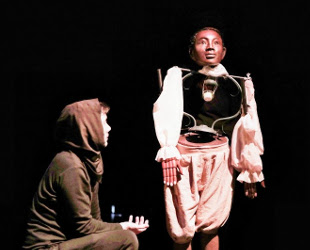 |
| Banneker Puppet. Photo by Theo Cote. |
Theater artist, director and master puppeteer Theodora Skipitares
has amazed audiences with her inventive, always socially relevant
productions for the past forty years. Her puppet cum actor conceptions
have ranged from intimate miniature solo performances to large scale
ensemble works that incorporate choreographic movement, video and
shadow play constructions, and puppets in shapes of all sizes and
styles that expand the theatrical space all around the audience.
Her theater is primarily a theater of imagery, soundscapes, interwoven
with narrative text of basic information, all of it live with a
minimum of electronic enhancement. Handicraft is the dominant aesthetic
source—the live human presence is the dominant force of action,
inside the puppet.
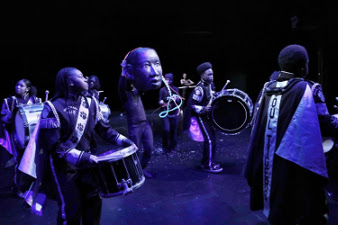 |
| Soul Tigers. Photo by Theo Cote. |
“The Transfiguration of Benjamin Banneker” is her most
recent conception brought to life with drummers from The Soul Tigers
Marching Band, Inc. , dance students from the Benjamin Banneker
Academy (a public high school in Brooklyn), augmented by professional
puppeteer/dancer/actors, and two actors, Reginald L. Barnes and
Tom Walker, who provide the narrative. Together with the accomplished
artistic team of composer/musician LaFrae Sci, choreographer Edisa
Weeks in collaboration with Jasmine Oton, puppetry director Jane
Catherine Shaw, set designers Donald Eastman, lighting designer
Jeffrey Nash, video design Kay Hines, and film animation artists
Holly Adams, Trevor Legeret & Klara Vertes, with Special Projects
by Jim Freeman, dramaturg Andrea Balis, Ms. Skipitares achieved
a complex performance interweaving all the arts into a contemplative
romp about and around Benjamin Banneker (1731-1806). He was a free
black man, a mathematical genius, self-taught, who dreamed himself
into the planetary realm and thus became an inventor, an astronomer,
and a visionary of a time when all men would be truly seen as equal
regardless of the color of their skin. And in 1791 he challenged
Thomas Jefferson to really live up to his own publicly expressed
ideal of human equality—but was courteously rebuffed! This
historical correspondence is presented in triplicate form: the writing
is projected onto a large screen behind two young black drummers
who translate the back and forth between Banneker and Jefferson
into a drum duel while Mr. Barnes as Banneker and Mr. Walker as
Jefferson read the respective texts.
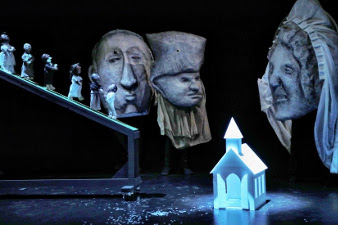 |
| Funeral of Benjamin Banneker. Photo by Theo
Cote. |
This segment concludes the first part that presents Benjamin Banneker’s
background as the grandson of Bannaka, an enslaved chieftain from
Mali and Molly, an English indentured servant— in her own
right a warrior woman who purchased her freedom and a small tobacco
farm with two slaves as help, and subsequently married her slave
Bannaka whom she freed. Benjamin inherited the title to the tobacco
farm and built his success as a tobacco farmer in Maryland. He becomes
known as an inventor of a clock, writes a respected almanac, and
spends his spare time at night observing the stars and making calculations
that are eventually recognized for their astronomical accuracy.
In 1790 he leaves the farm, the only time, to help survey the boundaries
of the new capital, Washington, D.C. Of course, his fame arouses
not only doubt that as a Negro he is capable of such intellectual
work but also envy. In the last years of his life, he finds himself
under threat, his house is attacked and burglarized, and finally
during his funeral his house is burnt down and with it his manuscripts,
except for one book kept by a neighbor.
Much of this narrative is presented in a series of visually enchanting
and colorful interpretations by the young dancers and puppeteers.
The Banneker puppet, handled by three puppeteers, gains an empathetic
dimension with its large portrait head and a small light like a
soul inside the upper body. The funeral is depicted by a long procession
of miniature puppets while above them hover the huge heads of Jefferson,
Martha W., Susanna, and Sheppard, the savior of Banneker’s
book of memoirs; they comment full of amazement and respect on his
accomplishments.
 |
| Astronaut puppet. Photo by Jane Catherine Shaw. |
Interestingly, Ms. Skipitares is not content with simply presenting
Banneker as an 18th century phenomenon of black genius but extends
the narrative by including in the second part, the story of Edward
Dwight who was trained during the Kennedy administration as the
first black astronaut but then excluded by NASA on the instigation
of Chuck Yeager—the sardonic commentary in Dwight’s
own words is poignant. Another astronaut is included, Frank Borman
who was a member of the Apollo team—his words echo Banneker’s
perception of the place and dimension of the human being visavis
space. Borman, while flying around in outer space, observes that
from his vantage point he is able to cover the entire earth with
his thumb. In the theater a miniature Dwight and a miniature Borman
are flying above the audience as we listen to their words. Another
interesting juxtaposition is MLK jr.’s exhortation to the
black actress who performs Uhura in “Star Trek”—again
a puppet in the starship hovers above the stage—that she must
stay with the show; it is the only show MLK and his wife Loretta
allow their children to watch—MLK as a “trekkie”?
Thus Skipitares reiterates the issue of black exclusion and black
accomplishments from the general history of scientific accomplishments
as a cultural blight while her inclusive performance celebrates
the possibility and potential of art as the place of unlimited collaboration.
A small addendum: The USPS found Benjamin Banneker worthy to put
his portrait on a 15 cent stamp.
|

